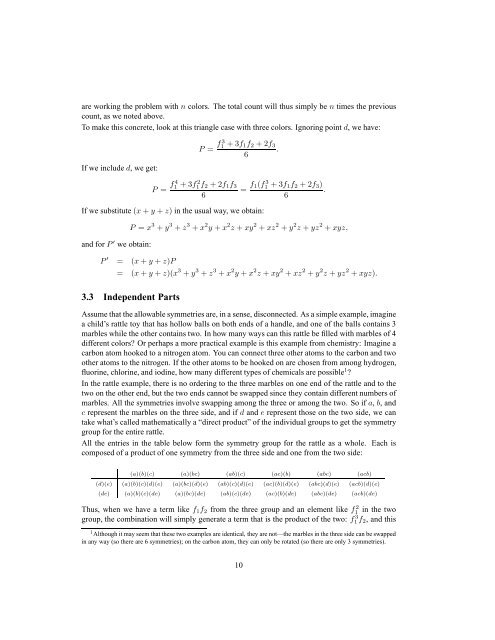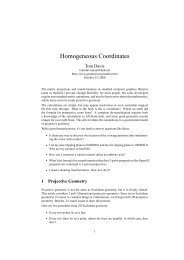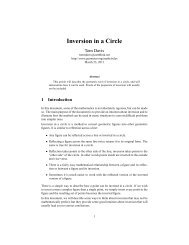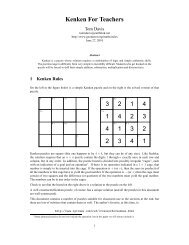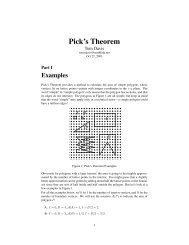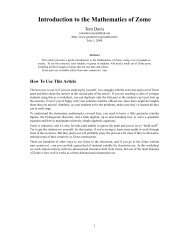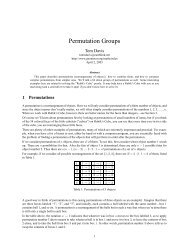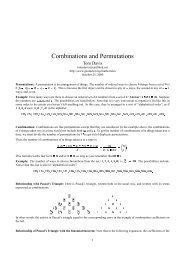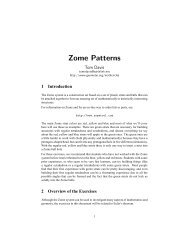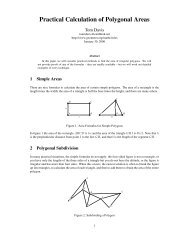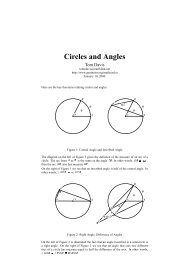P´olya's Counting Theory - Home Page -- Tom Davis
P´olya's Counting Theory - Home Page -- Tom Davis
P´olya's Counting Theory - Home Page -- Tom Davis
Create successful ePaper yourself
Turn your PDF publications into a flip-book with our unique Google optimized e-Paper software.
are working the problem with n colors. The total count will thus simply be n times the previous<br />
count, as we noted above.<br />
To make this concrete, look at this triangle case with three colors. Ignoring point d, we have:<br />
If we include d, we get:<br />
P = f3 1 + 3f 1f 2 + 2f 3<br />
.<br />
6<br />
P = f4 1 + 3f2 1 f 2 + 2f 1 f 3<br />
6<br />
= f 1(f1 3 + 3f 1f 2 + 2f 3 )<br />
.<br />
6<br />
If we substitute (x + y + z) in the usual way, we obtain:<br />
and for P ′ we obtain:<br />
P = x 3 + y 3 + z 3 + x 2 y + x 2 z + xy 2 + xz 2 + y 2 z + yz 2 + xyz,<br />
P ′ = (x + y + z)P<br />
= (x + y + z)(x 3 + y 3 + z 3 + x 2 y + x 2 z + xy 2 + xz 2 + y 2 z + yz 2 + xyz).<br />
3.3 Independent Parts<br />
Assume that the allowable symmetries are, in a sense, disconnected. As a simple example, imagine<br />
a child’s rattle toy that has hollow balls on both ends of a handle, and one of the balls contains 3<br />
marbles while the other contains two. In how many ways can this rattle be filled with marbles of 4<br />
different colors? Or perhaps a more practical example is this example from chemistry: Imagine a<br />
carbon atom hooked to a nitrogen atom. You can connect three other atoms to the carbon and two<br />
other atoms to the nitrogen. If the other atoms to be hooked on are chosen from among hydrogen,<br />
fluorine, chlorine, and iodine, how many different types of chemicals are possible 1 ?<br />
In the rattle example, there is no ordering to the three marbles on one end of the rattle and to the<br />
two on the other end, but the two ends cannot be swapped since they contain different numbers of<br />
marbles. All the symmetries involve swapping among the three or among the two. So if a, b, and<br />
c represent the marbles on the three side, and if d and e represent those on the two side, we can<br />
take what’s called mathematically a “direct product” of the individual groups to get the symmetry<br />
group for the entire rattle.<br />
All the entries in the table below form the symmetry group for the rattle as a whole. Each is<br />
composed of a product of one symmetry from the three side and one from the two side:<br />
(a)(b)(c) (a)(bc) (ab)(c) (ac)(b) (abc) (acb)<br />
(d)(e) (a)(b)(c)(d)(e) (a)(bc)(d)(e) (ab)(c)(d)(e) (ac)(b)(d)(e) (abc)(d)(e) (acb)(d)(e)<br />
(de) (a)(b)(c)(de) (a)(bc)(de) (ab)(c)(de) (ac)(b)(de) (abc)(de) (acb)(de)<br />
Thus, when we have a term like f 1 f 2 from the three group and an element like f1 2 in the two<br />
group, the combination will simply generate a term that is the product of the two: f1f 3 2 , and this<br />
1 Although it may seem that these two examples are identical, they are not—the marbles in the three side can be swapped<br />
in any way (so there are 6 symmetries); on the carbon atom, they can only be rotated (so there are only 3 symmetries).<br />
10


